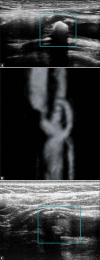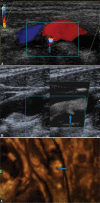Ultrasonography of vulnerable atherosclerotic plaque in the carotid arteries: B-mode imaging
- PMID: 32609972
- PMCID: PMC7418858
- DOI: 10.15557/JoU.2020.0022
Ultrasonography of vulnerable atherosclerotic plaque in the carotid arteries: B-mode imaging
Abstract
The most common type of stroke, i.e. ischemic stroke, is a great challenge for contemporary medicine as it poses both diagnostic and therapeutic difficulties. Atherosclerosis, which is rapidly beginning to affect more and more social groups, is the main cause of cerebrovascular accidents. Atherosclerosis is currently defined as a generalized, dynamic and heterogeneous inflammatory and immune process affecting arterial walls. Atherosclerotic plaque is the emanation of this disease. As the paradigm of the diagnosis of atherosclerosis has changed, it has become crucial to properly identify plaque instability within the carotid arteries by evaluating parameters and phenomena that signify a developing cascade of complications, eventually leading to stroke. Irrespective of the ultrasound technique employed, proper morphological evaluation of atherosclerotic plaque, involving observation of its echogenicity, i.e. subjective analysis of its structure, with the classification to Gray-Weale-Nicolaides types as well as assessment of the integrity of its surface, makes it possible to roughly evaluate plaque morphology and thereby its stability. This enables treatment planning and therapy monitoring. This evaluation should be a prelude to further diagnostic work-up, which involves non-invasive examinations that enable unambiguous assessment of plaque stability. These examinations include contrast-enhanced ultrasound to assess progression or recession of inflammation, which presents as plaque neovascularization, or shear wave elastography to objectively define tissue stiffness, and thereby its mineralization.
The most common type of stroke, i.e. ischemic stroke, is a great challenge for contemporary medicine as it poses both diagnostic and therapeutic difficulties. Atherosclerosis, which is rapidly beginning to affect more and more social groups, is the main cause of cerebrovascular accidents. Atherosclerosis is currently defined as a generalized, dynamic and heterogeneous inflammatory and immune process affecting arterial walls. Atherosclerotic plaque is the emanation of this disease. As the paradigm of the diagnosis of atherosclerosis has changed, it has become crucial to properly identify plaque instability within the carotid arteries by evaluating parameters and phenomena that signify a developing cascade of complications, eventually leading to stroke. Irrespective of the ultrasound technique employed, proper morphological evaluation of atherosclerotic plaque, involving observation of its echogenicity, i.e. subjective analysis of its structure, with the classification to Gray-Weale–Nicolaides types as well as assessment of the integrity of its surface, makes it possible to roughly evaluate plaque morphology and thereby its stability. This enables treatment planning and therapy monitoring. This evaluation should be a prelude to further diagnostic work-up, which involves non-invasive examinations that enable unambiguous assessment of plaque stability. These examinations include contrast-enhanced ultrasound to assess progression or recession of inflammation, which presents as plaque neovascularization, or shear wave elastography to objectively define tissue stiffness, and thereby its mineralization.
Conflict of interest statement
Figures


















Similar articles
-
Ultrasound methods of imaging atherosclerotic plaque in carotid arteries: examinations using contrast agents.J Ultrason. 2020 Nov;20(82):e191-e200. doi: 10.15557/JoU.2020.0032. Epub 2020 Sep 28. J Ultrason. 2020. PMID: 33365156 Free PMC article.
-
Advanced ultrasound methods in assessment of carotid plaque instability: a prospective multimodal study.BMC Neurol. 2020 Jan 29;20(1):39. doi: 10.1186/s12883-020-1620-z. BMC Neurol. 2020. PMID: 31996153 Free PMC article.
-
B-mode ultrasound and spiral CT for the assessment of carotid atherosclerosis.Neuroimaging Clin N Am. 2002 Aug;12(3):421-35. doi: 10.1016/s1052-5149(02)00015-1. Neuroimaging Clin N Am. 2002. PMID: 12486830 Review.
-
Contrast-enhanced ultrasound imaging of intraplaque neovascularization and its correlation to plaque echogenicity in human carotid arteries atherosclerosis.Int J Cardiol. 2016 Nov 15;223:917-922. doi: 10.1016/j.ijcard.2016.08.261. Epub 2016 Aug 16. Int J Cardiol. 2016. PMID: 27597156
-
Ultrasound Methods in the Evaluation of Atherosclerosis: From Pathophysiology to Clinic.Biomedicines. 2021 Apr 13;9(4):418. doi: 10.3390/biomedicines9040418. Biomedicines. 2021. PMID: 33924492 Free PMC article. Review.
Cited by
-
Contrast-Enhanced Ultrasound Feasibility in Assessing Carotid Plaque Vulnerability-Narrative Review.J Clin Med. 2023 Oct 9;12(19):6416. doi: 10.3390/jcm12196416. J Clin Med. 2023. PMID: 37835061 Free PMC article. Review.
-
Diagnostics of atherosclerosis: Overview of the existing methods.Front Cardiovasc Med. 2023 May 9;10:1134097. doi: 10.3389/fcvm.2023.1134097. eCollection 2023. Front Cardiovasc Med. 2023. PMID: 37229223 Free PMC article. Review.
-
Carotid Plaque Composition and the Importance of Non-Invasive in Imaging Stroke Prevention.Front Cardiovasc Med. 2022 May 16;9:885483. doi: 10.3389/fcvm.2022.885483. eCollection 2022. Front Cardiovasc Med. 2022. PMID: 35651908 Free PMC article. Review.
-
Impact of cerebral collateral flow on stroke outcomes after carotid stenting.Ann Clin Transl Neurol. 2023 Nov;10(11):2065-2073. doi: 10.1002/acn3.51894. Epub 2023 Sep 1. Ann Clin Transl Neurol. 2023. PMID: 37658584 Free PMC article.
-
The utility of ultrasound and computed tomography in the assessment of carotid artery plaque vulnerability-A mini review.Front Cardiovasc Med. 2022 Nov 16;9:1023562. doi: 10.3389/fcvm.2022.1023562. eCollection 2022. Front Cardiovasc Med. 2022. PMID: 36465468 Free PMC article. Review.
References
-
- Grabowska-Fudala B, Jaracz K, Górna K: Zapadalność, śmiertelność i umieralność z powodu udarów mózgu – aktualne tendencje i prognozy na przyszłość. Przegl Emidemiol 2010; 64: 439–442. - PubMed
-
- The World Health Organization MONICA Project (monitoring trends and determinants in cardiovascular disease): a major international collaboration WHO MONICA Project Principal Investigators. J Clin Epidemiol 1988; 41: 105–114. - PubMed
-
- de Bray JM: Consensus concerning the morphology and the risk of carotid plaques. Cerebrovasc Dis 1997; 7: 289–296.
-
- Li J, Mi D, Pu Y, Zou X, Pan Y, Soo Y et al. : Comparison of carotid atherosclerotic plaque characteristics between patients with first-time and recurrent acute ischaemic stroke using B-mode ultrasound. Neurol Res 2015: 1–5. - PubMed
-
- Nyman E, Vanoli D, Näslund U, Grönlund C: Inter-sonographer reproducibility of carotid ultrasound plaque detection using Mannheim consensus in subclinical atherosclerosis. Clin Physiol Funct Imaging 2020; 40: 46–51. - PubMed
LinkOut - more resources
Full Text Sources
Medical
Research Materials
